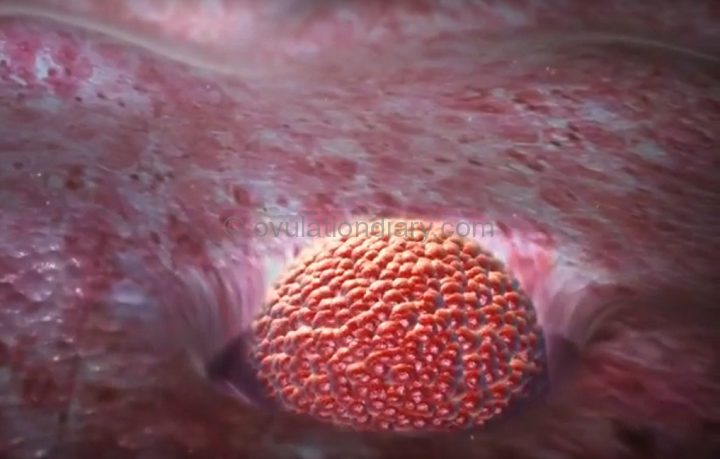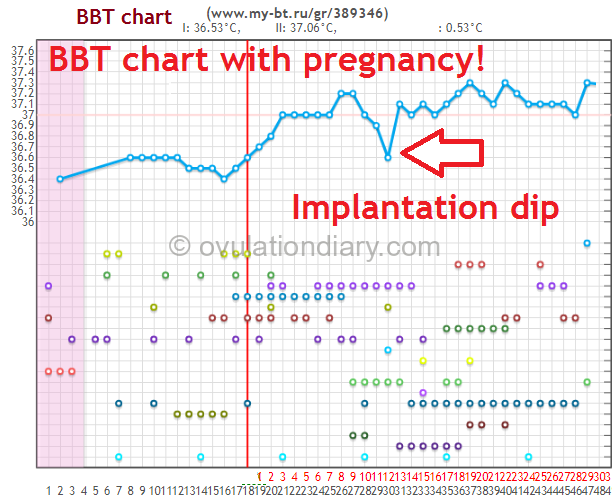
Implantation occurs on the 7-10th day past ovulation (DPO). The most common signs of implantation:
- pain in the lower abdomen or lower back;
- dizziness, weakness;
- spotting no more than a day;
- drop in basal body temperature on the 7-10th DPO for 1 day by 0.2-0.4 °C (0.36–0.72 °F);
- a sharp sensitivity to certain odors;
- body temperature is 37.1-37.4 °C (98.78–99.32 °F), cold sensation;
- nausea;
- emotional instability.
How does embryo implantation work after ovulation
If, at the end of ovulation, the egg merges with the sperm, the next, extremely important stage of its evolution begins. The implantation into the uterine wall should take place. This event completes embryogenesis, and the fetal development phase begins.
![]() For some pathologies, implantation risks not taking place or embryo rejection will quickly occur. The task is also complicated by the fact that a fertilized egg (zygote) contains male genes alien to the woman’s body. “Implantation from a kindred miracle!” – says folk wisdom and modern medicine partly agrees with this statement.
For some pathologies, implantation risks not taking place or embryo rejection will quickly occur. The task is also complicated by the fact that a fertilized egg (zygote) contains male genes alien to the woman’s body. “Implantation from a kindred miracle!” – says folk wisdom and modern medicine partly agrees with this statement.
Having penetrated the uterus, the zygote gets rid of the outer protective membrane. Then gradually fixes into the endometrium. After implantation, the egg becomes a full-fledged embryo and develops further due to the beneficial substances contained in the cells of the uterine wall. But if something went wrong, the body rejects the embryo and everything ends with menstruation.
The success of implantation is affected by:
- the optimal thickness of the endometrial layer (10-13 mm);
- the amount of the hormone progesterone produced by the corpus luteum;
- saturation of the inner lining of the uterus with nutrients.
![]() This is interesting(!): In unusual situations (Frozen Embryo Transfer, woman’s age from 35 years, IVF), the increased thickness and density of the outer layer of the zygote can become a cause of complications.
This is interesting(!): In unusual situations (Frozen Embryo Transfer, woman’s age from 35 years, IVF), the increased thickness and density of the outer layer of the zygote can become a cause of complications.
On which day of ovulation does implantation occur?
It is not possible to determine the exact day of embryo implantation after ovulation. The situation is developing according to an individual scenario.
The zygote appears in the uterus on the 4-6th day past ovulation. After 1-2 days, it begins to invade the endometrium. It lasts for about 40 hours. The process may be periodically suspended and intensified.

In most cases, implantation occurs on the 7-10th day after ovulation.
As medical practice shows, approximately 2% of women experience this event on the 5-6th DPO, 2.8% – on the 12th DPO. Many gynecologists consider the completion of implantation the formation of a functional placenta during the 20th week of gestation.
Signs of embryo attachment to the uterus after ovulation
The introduction of the embryo into the wall of the uterus dramatically disrupts the usual functioning of the body, accompanied by a violation of its upper layers and blood vessels. Along the way, there is a rapid change in the hormonal background.
If the embryo is attached after ovulation, blood and urine tests will show a double increase in the concentration of HCG (a hormonal substance synthesized by the tissues of the ovum) every one and a half days. The situation changes only after the 5th week of pregnancy. Thus, a pregnancy test before delay can give a positive result already on the 8-14th DPO (the days past ovulation).
Here is an article where I mentioned all the most likely symptoms and methods for determining an early pregnancy before missed periods.
Basal body temperature during embryo implantation
Analysis of changes in basal body temperature is a simple and quite informative way of gynecological diagnosis.

The conception chart, compiled on the basis of daily rectal (oral or vaginal) temperature measurements in a state of complete rest, a stable 35-day menstrual cycle, it looks like this (see the chart above):
- 36.4-36.5 °C (97.52-97.7 °F) in the first 19 days of the cycle.
- 36.3°C (97.34 °F) on the 21st day (a day or two before ovulation).
- 36.4°C (97.52 °F) on the 22nd day (ovulation).
- Decrease in indicators by 0.2-0.3°C or 0.36–0.54 °F(28 DC) – implantation dip (retraction) of the basal body temperature with the introduction of the embryo into the endometrium. Depending on individual circumstances, this event may shift for a period of 7-12 days of the luteal phase.
- Next, the temperature approaches the previous implantation retraction mark (36.8-37°C or 98.24-98.60 °F) and stabilizes at this level.
How long does the implantation dip of BBT last
The basal body temperature retraction lasts no more than a day, after which the BBT rises and returns to the normal limits of the luteal phase of the cycle.
Implantation retraction on the basal body temperature chart indicates the beginning of the active production of estrogen (lowers temperature) after the onset of pregnancy. This is a fleeting process.
Is there always an implantation drop of basal body temperature
Implantation retraction does not always accompany the process of embryo fixation. Of course, it may be difficult to identify this characteristic sign of pregnancy. Gynecologists note and numerous «pregnant» BBT charts confirm that about 75% of expectant mothers could not clearly track the phase of implantation retraction in their basal charts.
In order not to miss an important period, you should study the features of your body well. It is necessary to monitor daily fluctuations in basal body temperature for at least three months in compliance with the rules of measurement.
Implantation bleeding after ovulation – normal and deviation
According to statistics, bleeding accompanies embryo implantation in approximately 20% of expectant mothers. This is a natural phenomenon since the penetration of the egg into the wall of the uterus is accompanied by a hormonal burst, a violation of blood vessels and tissue integrity.
Signs of implantation bleeding:
- a little discharge – from one to several light pink or brown drops. During implantation, no more than a few drops of blood are normally released;
- weak pain in the lower abdomen;
- usually, this happens a week and a half after the fertilization of the egg, on the 21-24th DC (with the classic 28-day cycle) and a 5-7 days before periods;
- discharge appears in the period from several hours to two days;
- basal body temperature during implantation bleeding remains normal or drops sharply for 1 day (implantation dip);
- other indirect signs of embryo implantation are observed.
Any non-compliance with these criteria should alert. Severe pain, profuse and clot discharges during the implantation may indicate sexual infections, various pathological conditions: ectopic pregnancy, threatened miscarriage, inflammation, epithelial damage and other problems.
There is a separate article on ovulationdiary.com about all the signs of implantation after which a pregnancy test can become positive.
I wish you a planned, easy and healthy pregnancy!
